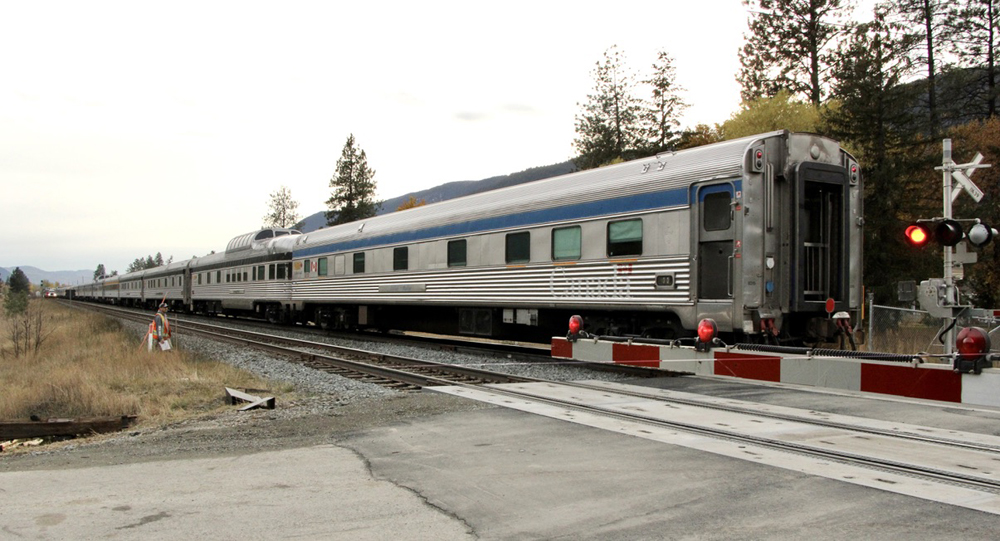
OTTAWA — VIA Rail Canada no longer needs to run unoccupied “buffer” cars on trains with stainless steel Budd “HEP-1” and “HEP-2” passenger cars and rail diesel equipment, Transport Canada has announced.
The order, effective at 11:59:59 p.m. EDT on Wednesday, May 17, repeals a previous order issued last October after questions surfaced about the structural integrity of the 1950s-vintage rolling stock, refurbished to accommodate head-end power. That equipment is used on the Quebec City-Windsor corridor and all VIA regional and long-distance service [see “VIA: Need for ‘in-depth’ inspections led to buffer car decision,” Trains News Wire, Oct. 19, 2022].
“VIA has since conducted a series of simulations, testing, and inspections, which concluded the cars showed no additional deficiencies, and the cars are still compliant with structural design standards for crashworthiness,” says the new order. At least four pieces of equipment —a coach, diner, Rail Diesel Car, and non-Prestige class Chateau sleeping car — were destroyed in the testing process.
Transport Canada and VIA have never explained exactly what triggered the original decision, and have yet to elaborate on results of testing that was supposed to have concluded on March 31, 2023.
Reports by sources familiar with the testing told Trains News Wire in February about issues that might remain, but that horizontal buff strength integrity — a primary crashworthiness consideration — had been confirmed [see “Truck bolster corrosion said to be a main concern …,” News Wire,” Feb. 22, 2022]. The order apparently means the cars now have a clean bill of health.
Trains departing or en route early today continued to operate with the buffer cars, but News Wire has learned some VIA trains dispatched since midday have been spotted without them.
The order means that VIA will be able to address heavy travel demand with coaches and sleeping cars had been relegated to deadhead duty since last fall. It is likely that pets will again be permitted to ride in baggage cars. That had ended because the prior order required buffer cars at both ends of a consist, and unoccupied baggage cars served that purpose. When pets were carried in the cars, their owners were allowed to enter the cars to visit and otherwise attend to the animals.
— Updated at 6 p.m. CDT to clarify equipment destroyed in structural testing.














I’m just pleased that the Canadian will again present a normal appearance. And, no doubt, passengers will be pleased too.
Did they publish which cars where sacrificed?
This quote is absolutely priceless:
“VIA has … concluded the cars showed no additional deficiencies, and the cars are still compliant with structural design standards for crashworthiness,” says the new order. At least four pieces of equipment … were destroyed in the testing process.”
They destroyed the cars and still couldn’t find any deficiencies. “I don’t know, Moe. What’s a squeak look like?” –C. Howard
“They destroyed the cars and still couldn’t find any deficiencies. “I don’t know, Moe. What’s a squeak look like?” –C. Howard”
I believe you mean a “Pain in the Pullman”
“https://www.youtube.com/watch?v=UJZeSw9QgVQ”
In my view, this is typical CYA behaviour of all involved, inspectors, engineers, management, government bureaucrats, politicians, et all. Yes, the cars are old. But they are of Stainless Steel construction. Would an idler car have made a major difference in that infamous Dalehurst (Hinton, AB) freight train collision with VIA’s ‘Canadian’? I think not. Destroying four heritage cars and still not revealing the original reasoning or the testing results are typical conduct for current quasi-government personnel and their ilk. Perhaps they are still translating the report into both “official” languages.
Worked with many professional engineers and a lack of practical experience or unfamiliar with the equipment they were reviewing often led to wild goose chases. Unfortunately in todays workplace lack of experience is running rampant, all the degrees and diplomas are irrelevant unless you have experience.
Excuse me, Sir! A deficiency was noted, which Professional Engineers believed required destructive testing was required to determine if there was an public safety issue. They where acting as professionals dealing with a mode of public transport. The cars are classics and they are 70 years old. It is called being Proactive as apposed to reactive. This is just Canadian Professional Engineers being Proactive and doing their job.
These cars are all nearing 70 yrs old time to either end the service or commit to its future & invest in a new fleet.
Remember the issues with the old Amtrak diners. Better to error on the safe side.
What a waste of time, money & four passenger cars.
ESPECIALLY since Transport Canada and VIA Rail had never explained what triggered the original decision or elaborate on the need for same. If structural integrity would be the case in a collision…empty cars are not going to do a hell of a lot to mitigate a rear end collision with a freight train.